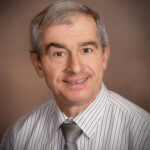Working with Physicians, Meeting Patients
“While in the clinic, physicians talked to me about their patients and asked whether I would do anything differently. Often, by looking at the responses in their patients, I thought they were doing pretty well, and I agreed with the treatment. It all made sense to me.”
Dr. Halverson delivered a daily lecture in Nepal, “a brain dump to the rheumatology fellows,” he says. The lecture topics covered a broad range: rheumatoid arthritis, gout, lupus, spondyloarthropathies, and joint injections. During Grand Rounds, he gave a talk on the microbiome and how it contributes to spondyloarthritis and other forms of arthritis.
“Medicine is a remarkable way to see a bit more into the culture. You see people with problems who are much more open and willing to interact with a foreigner. You can comfortably look at people and even touch them as part of the medical care, which makes the experience much fuller,” he says.
In talking with the two rheumatology fellows—Ujjwal Risal, MD, and Jiwan Poudel, MD—Dr. Halverson learned more about medicine and the country. “For many years, Nepal hardly had a chance because of political instability, but there is more hope now … but change seems frustratingly slow. The fellows say the culture is changing, especially for the kids who now play videogames, watch YouTube, and engage on the internet to the exclusion of more normal family interaction.”
A car trip with the head of the department on Dr. Halverson’s last full day of his week in Nepal took him east of the Kathmandou Valley, where the Himalayas seemed to “almost mysteriously reach high above the skyline” even though 40 to 50 miles away.
The second leg of the journey that day was a house call on a woman and her daughter, both with rheumatoid arthritis. “This was a family affair at their hilltop farm with three generations, in-laws and some locals coming by. We had lunch and toured the steep hillside farm with several hundred mandarin orange trees and other wonderful produce.
“It was such a privilege to experience Nepali people in a non-urban setting. It was very relaxed and enjoyable. There is real value in Nepal in spending ‘nonproductive’ time together, which seems so different than in the West where everybody has to be doing something, which may or may not mean spending time in relationship with one’s group.”
Clinic Needs
For people who want to volunteer their time by providing teaching assistance at the clinic, Dr. Halverson advises an understanding that the experience will be different. “It’s more rigorous and is not the kind of medicine we have in this country in terms of the facilities and where you are seeing patients. It is a poor country, and they have a lot of beds crowded into the hospital rooms. But that’s the way they have been doing things, and it works for them.”
Dr. Halverson noted that Dr. Paudyal and other physicians at the clinic are “surprisingly relaxed about having other physicians visit, and they are interested in having others come and participate in the educational activities of his program. You can be there with them and maybe examine a patient a little bit, but you are not going there to practice medicine. You would be there more as an educational consultant, teacher.
“The clinic is providing rheumatology services at a higher level than anyone else in the Kathmandou Valley, and they will be recognized for it,” he says.
As for lodging in the country and getting around the crowded, and often unnamed, streets and unmarked buildings, Dr. Halverson advises adopting a flexible approach to scheduling, staying alert on market streets that are teeming with jostling pedestrians and motor bikes, taking time to see the historic and religious sites, and bringing long underwear for those cold nights in a hotel room.
Those interested in volunteering their time should contact Dr. Paudyal via email at [email protected]. For more information about the hospital and PAHS here.

